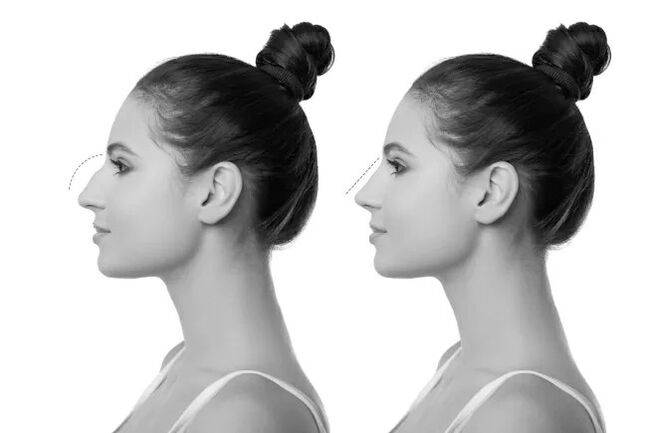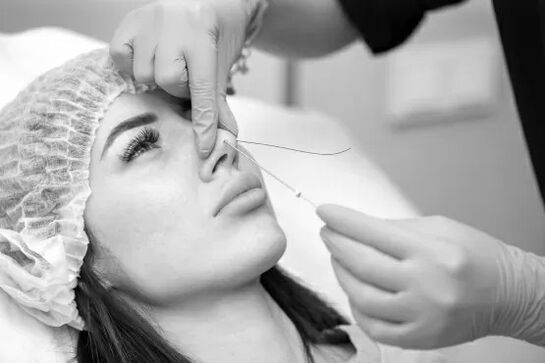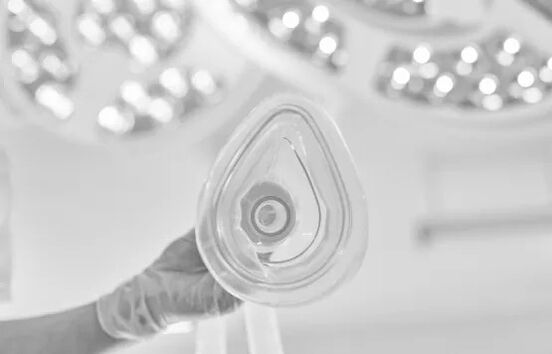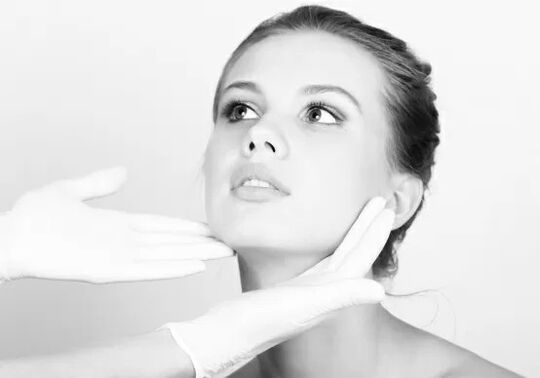Every third person on the planet has thought about nose correction at least once. 70% of patients choose rhinoplasty because they are 100% dissatisfied with its appearance and want to solve aesthetic problems: remove the hump, make their nose thinner, smaller, smoother. 30% of patients opt for rhinoplasty for medical reasons - nasal injury, difficulty breathing, different nasal septum or frequent sinusitis.
Problems with the shape of the tip of the nose are not uncommon. But don’t be shy, everything can be fixed. If shape defects can be corrected with clothing, diet, or sports, consult a plastic surgeon to correct your nose or lips.
All the features of the procedure, preparation for plastic surgery, and other important stages will be discussed in this article.
Indications and contraindications: medical, aesthetic, indirect, absolute

Rhinoplasty is a 1-2 hour surgical procedure. As a result, the patient’s appearance changes and the face becomes more attractive. Before exporting the plastic, you must agree with the doctor at all points and be thoroughly prepared to perform it: pass the tests, follow the diet, give up the cigarette and alcohol at least a week before surgery.
Indications for surgery
The indications for the procedure are innate and acquired.
Innate indications for plastic surgeries are a variety of aesthetic and physiological defects: hook-shaped, forked, thick or drooping tip, pushed to the side, nostril too wide or narrow.
Surgery may be needed after injuries or illnesses in which the nose is bent, and in case of difficulty breathing, due to changes in the structure of the organ or age (skin aging). The above indications shall be deemed to have been acquired.
To restore or correct the tip of the nose, you should consult a surgeon if surgery is required, taking into account cartilage density, skin and tissue thickness, nose length, width, and other factors. The patient’s wishes are always taken into account and implemented as much as possible, but the final decision is made with the doctor because excessive removal of cartilage can lead to poor health.
Before surgery, you should examine the nasal cartilage and also make sure that the skin in the respiratory area is healthy - there are no signs of inflammation or infection.
Contraindications to surgery
Nose tip correction is a serious procedure that must be approached consciously. What are the contraindications to the procedure?
- Disease.The surgery is performed from the age of 18. At this age, tissue formation occurs completely. However, surgeons recommend nasal tip correction between the ages of 20 and 35. This completes the formation of bones and cartilage, the skin is supple and regeneration is active after the procedure.
- Blood clotting problems.If the patient has poor blood clotting, the risk of surgery is higher than usual, so it is better to refuse to perform it.
- Exacerbation of chronic diseases.Surgeons do not recommend performing surgery during disease exacerbations. It is better to wait until the health condition returns to normal and be examined. Rhinoplasty can only be decided if there are positive test results.
- Viral diseases, infections, inflammations.It should be remembered that if there are at least minimal health problems, it is better to postpone surgery until full recovery.
- Oncology.Rhinoplasty is contraindicated in oncology patients.
- Menstruation.Surgery is contraindicated during menstruation. The correction should be made within two weeks of the end of menstruation.
It is contraindicated to perform plastic surgery during pregnancy or lactation. Prior to surgery, the patient should be examined and examined to ensure the necessary preparations for rhinoplasty.
Other ways of correction. Why rhinoplasty is the safest method

To correct the nose, surgeons use different surgical techniques, depending on the client’s wishes and the outcome that the patient expects. However, you can also find other ways to correct the tip of your nose on the mesh.
Tweezers
Online stores have so-called "clamps for nose correction. "Manufacturers ensure that if the correctors are worn 2-3 times a day, the effect will be noticeable compared to surgery. But of course this is far from the truth. Clips or other pseudo-tools do not work for nose correction. If there is any effect, it will be short-term - 2-3 weeks, and the correction is insignificant.
Tasks
There are a number of exercises for the face that allow you to correct your shape. These exercises are helpful in maintaining muscle tone, cheekbones, and double chin, but do not work in correcting cartilage shape. The effect after systemic exercise lasts for 2 weeks.
Repair with threads
The tapping technique is performed by a specialist using micro-punctures with a special needle. Specially designed serrated fibers are placed in the skin of the nose to form a frame. The threads are inserted through small punctures and are held in place by the frame. After two days, the doctor removes the ends of the fibers and the patient sees the end result, which lasts for about 3 years.
Use of hormonal drugs
You can also take a course of hormonal medications to correct the tip of the nose. You should first consult an endocrinologist. If there is no contraindication, a hormonal drug can be administered. This procedure is performed to remove excess soft tissue and lift the tip. You will need to go through a 2-3 week procedure to make the correction. It is worth noting that the drugs have a temporary effect - from 3 months to 2 years, depending on the drug of your choice.
Surgical correction
Experts say rhinoplasty is the most reliable and effective method of correction. Unlike previous methods, rhinoplasty gives a lifelong result. The procedure lasts 1-2 hours under local or general anesthesia. The main advantages of the operation:
- all possible correction options (lower or raise the tip, reduce, straighten, or narrow the tip of the nose);
- elimination of respiratory problems;
- lifetime result;
- correction of injuries, birth defects.
3 Techniques for performing the operation. What is the difference
There are several types of rhinoplasty: classical closed, open, and hybrid methods. Surgeons resort to different types of plastic surgeries depending on the result achieved, the shape of the nose, the position of the bone and cartilage tissues, and other factors.
A classic feature of closed plastic surgeries is that it can be used to correct the back of the nose, but peak correction will be more difficult than using an open one. In this method, incisions are made inside the nasal passages, and the apex can only be accessed if the cartilage is removed into the incision. But there are pros - no visible scars remain after surgery. The closed plastic is suitable for removing the hump or correcting the curvature of the bone tissue.
In the case of open surgery, the surgeon makes an additional incision between the nostrils. This contributes to better access to the structures of the nose, a wide range of options to change the size and shape of the nose. The scar will be almost invisible and small after the procedure. You can use this method to reshape the tip of your nose more effectively (compared to the closed method). The disadvantages are the possible formation of a small scar on the outside of the nose and the longer healing period. A few months after surgery, the scar will become smaller and can be removed using additional medications and creams that the surgeon will recommend if needed.
Because of the disadvantages of the above methods, surgeons have developed a combined plastic technique. When used, there are incisions inside the nose that are typical of both methods, but unlike the open method, there are no external incisions in the skin.
The combined (also known as "hybrid") method has been developed to take into account all the advantages and disadvantages of the closed and open methods.
The main benefits are the ability to change the structure of the nose as much as possible and not leave visible scars. Recovery after the combined method occurs within 2 weeks and there is no visible scar on the skin.
When using the hybrid method, the surgeon has the opportunity to make corrections during the surgery as well as check the desired result, avoiding the possibility of excessive or insufficient correction. The combined method has only one disadvantage - it is more technically complex.
A few words about something important. Preparing for surgery

You should undergo training before performing rhinoplasty. You should consult a plastic surgeon to discuss the changes you want. The surgeon examines his nose and explains the reality of achieving the desired result. During the consultation, questions about limitations, operation, specifics of preparation, subsequent rehabilitation, and possible complications are discussed.
Prior to surgery, the patient should be examined to ensure that there are no contraindications and should pass the following tests:
- blood against HIV infection and hepatitis C and B;
- clinical blood test;
- blood biochemistry;
- laboratory analysis of urine;
- analysis of the prothrombin index;
- fluorography;
- electrocardiography;
- test for tumor markers;
- X - ray.
In addition, the patient should listen to the doctor's recommendations and follow them. Avoid drinking alcohol one week before surgery, stop smoking, do not use blood thinners, do not drink water and do not eat food for five hours before the procedure. It is important to refrain from active time and walking during the scorching sun for a few days before rhinoplasty.
The course of the operation and its main stages

Rhinoplasty is performed under general or local anesthesia. The choice of type of anesthesia depends on both the wishes of the client and the specifics of the surgery, as well as the method that the plastic surgeon will use to perform it. The patient can always share their wishes about anesthesia, but the final decision is made by the doctor. The process and quality of post-rhinoplasty rehabilitation also depends on the choice of type of anesthesia.
Local anesthesia is used for minor nasal correction with hormonal injections, fillers, or fibers. These correction methods do not cause severe pain, so in most cases, general anesthesia is not required. But this type of anesthesia is practically not used in rhinoplasty when the surgeon has to touch the bones of the nose or cartilage.
General anesthesia is used by the surgeon in most cases. This type of anesthesia allows the pain to be completely avoided during surgery and the patient will have no memories of the surgery.
The operation takes 1-2 hours. After anesthesia, the surgeon makes an incision in the skin or mucous membrane. Depending on the patient's wishes and the specific case, the doctor will choose an open or closed method for the operation.
During rhinoplasty, the doctor separates the soft tissues of the nose from the bone and cartilage in the nasal cavity. He then performs the movement of cartilage and bone fragments, modeling a new shape of the nose. After the manipulations, the plastic surgeon applies absorbent sutures to the skin or mucous membranes, depending on where the incision was made. The next step is to tampon the nasal passages with large gauze swabs. The final stage of the operation is the introduction of a fixing gypsum casting.
The type of incision is chosen by the surgeon depending on the structure of the nose, the complexity of the procedure, and the preferences of the surgeon’s work. The cut can be axial, perpendicular, oval or square.
Rhinoplasty itself is done in three main ways: open, closed and combined. The characteristics of each method are described in the "Types of operations" section
The choice of method of plastic surgery is presented directly to the patient, but doctors recommend that they choose the lowest traumatic methods. Surgeons say the least traumatic methods are closed and combined because when they are used, the incision is small and the recovery after surgery is faster.
Surgeon's recommendations in the postoperative period. How to avoid complications

Postoperative rehabilitation averages 20-25 days. If the rhinoplasty has been performed under general anesthesia, the patient should also be hospitalized for 24 hours after surgery.
For three days after surgery, there should be gauze or a cotton swab in the nasal cavity to ensure immobility of the new forms and prevent swelling. 5-8 after plastic surgery. During the day (depending on the rate of healing) the suture material is removed. After a week or 10 days, the patient is removed from the plaster, and the hematoma and swelling gradually disappear.
Doctor's recommendations in the postoperative period:
- Sleep on your back, be sure to use a high pillow.
- To reduce the discomfort associated with dry mouth (as a possible consequence of the procedure), use special solutions or pastes for softening.
- Do not abuse alcohol or smoking.
- Refusal to go to the baths, solariums, saunas.
- Do not wear glasses.
- It is forbidden to load yourself with physical activity.
- Temporarily stop consuming hot food and beverages.
- Do not touch, knead or feel your nose.
Possible complications
Complications after rhinoplasty are rare. Some of them appear immediately after correction, while others occur in later stages of recovery. Natural complications include edema and bruising. The external signs of swelling disappear within a week after plastic surgery, and deep swellings disappear after six months. Breathing difficulty alone disappears 10 days after surgery.
In order to better protect yourself from possible complications, it is important that you carefully choose a specialist, clinic, and provide full information about your health condition, injuries, or illnesses, if any. The end result of the surgery performed also depends on strict adherence to the doctor’s recommendations during the rehabilitation period.
Conclusion
Rhinoplasty is used by both women and men of any age. Surgeons are advised to perform surgery to correct the tip of the nose at a young age and not postpone it. It is important that a full examination is performed to make sure that plastic surgery has no contraindications. The most popular indications for rhinoplasty:
- nose tip correction (large, sharp or round);
- long nose;
- wide bridge of the nose;
- raising or narrowing the tip of the nose;
- elimination of asymmetry;
- shortness of breath;
- eliminating the consequences of injury or poor quality rhinoplasty;
- split nasal tip correction.
If the patient has a small defect, the surgery is performed under local anesthesia. In 90% of cases, rhinoplasty is performed under general anesthesia. The procedure itself takes an hour or two. The way the procedure is performed (open or closed) is based on many factors. This includes the complexity of the nasal defect and the client’s wishes. But the final decision remains with the plastic surgeon.
The quality of the rhinoplasty and the end result depend directly on the choice of specialist and clinic, so this needs to be approached carefully.






















